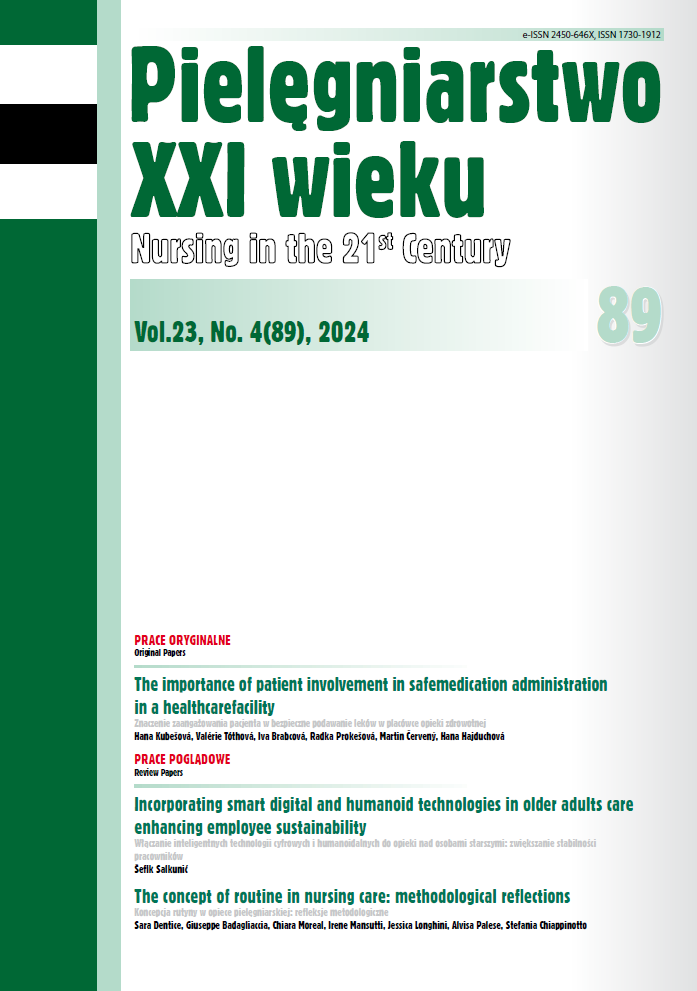Co czyni poród trudnym? Predyktory i cechy trudnego porodu z perspektywy kobiet i położnych
DOI:
https://doi.org/10.2478/pielxxiw-2024-0038Słowa kluczowe:
opieka okołoporodowa, trudny poród, doświadczenie położnych, doświadczenie kobiet rodzącychAbstrakt
CO CZYNI PORÓD TRUDNYM? PREDYKTORY I CECHY TRUDNEGO PORODU Z PERSPEKTYWY KOBIET I POŁOŻNYCH
Cel pracy. Celem tego badania było określenie cech porodu, które czynią go „trudnym porodem” z perspektywy kobiet i położnych.
Materiał i metody. Przekrojowe, wstępne badanie oparte na analizie formularza obserwacji porodu i oceny poziomu trudności porodu opracowanego na potrzeby tego badania i wypełnionego przez położne uczestniczące w badaniu. W badaniu wzięło udział 31 położnych pracujących na sali porodowej oraz w domu narodzin w jednym ze szpitali w Warszawie oraz 152 kobiety, które rodziły tam lub w domu pod opieką jednej z położnych biorących udział w badaniu.
Wyniki. Częściej oceniały swój poród jako trudny kobiety, które korzystały ze znieczulenia zewnątrzoponowego, rodziły dzieci o większej masie a także te, które wykazywały negatywne nastawienie do porodu oraz doświadczały przedłużonego pierwszego etapu porodu. W opinii położnych, oceniane jako trudniejsze były porody z przedłużającym się drugim okresem, nieprawidłowymi wzorcami skurczów macicy oraz wydłużoną fazą utajoną i pierwszym okresem porodu.
Wnioski. Niektóre porody, pomimo tego, że są klasyfikowane jako fizjologiczne, wymagają większego wysiłku zarówno ze strony położnej, jak i rodzącej kobiety i kończą się większym poziomem zmęczenia u obojga. Predyktory trudnego porodu powinny być wykorzystywane przez personel medyczny jako wskazówki pomagające zidentyfikować kobiety zagrożone negatywnymi doświadczeniami porodowymi.
Bibliografia
1. World Health Organization. WHO recommendations Intrapartum care for a positive childbirth experience. [Internet]. 2018. Available from: https://apps.who.int/iris/bitstream/handle/10665/260178/9789241550215-eng.pdf
2. Shorey S, Yang YY, Ang E. The impact of negative childbirth experience on future reproductive decisions: A quantitative systematic review. J. Adv. Nurs. 2018;74(6):1236-1244.
3. Baranowska B. The Quality of Childbirth in The Light of Research the New Guidelines of The World Health Organization and Polish Perinatal Care Standards. Dev. Period. Med. 2019;23(1):54-59.
4. Olza I, Leahy-Warren P, Benyamini Y, et al. Women’s psychological experiences of physiological childbirth: a meta-synthesis. BMJ Open. 2018;8(10):e020347.
5. Ford E, Ayers S. Support during birth interacts with prior trauma and birth intervention to predict postnatal post-traumatic stress symptoms. Psychol. Health. 2011;26(12):1553-1570.
6. Dewi IS, Anggraini H, Silaban TDS. Relationship between Mal Presentation, Contractions and Baby Weight with Prolonged Parturition in the Teluk Lubuk Health Center Working Area in 2020. Sci. Midwifery. 2022;10(2):574-579.
7. Arya SB, Sharma A, Goel JK, et al. Study of the Feto-maternal Outcome in Occipito-posterior Position at the Onset of Labor. SRMS J. Med. Sci. 2017;2(02):61-65.
8. O’Riordan N, Robson M, McAuliffe FM. Management of poor progress in labour. Obstet. Gynaecol. Reprod. Med. 2021;31(12):342-350.
9. Ängeby K, Sandin-Bojö AK, Persenius M, et al. Women’s labour experiences and quality of care in relation to a prolonged latent phase of labour. Midwifery. 2019;77:155-164.
10. Kempe P, Vikström-Bolin M. Women’s satisfaction with the birthing experience in relation to duration of labour, obstetric interventions and mode of birth. Eur J Obstet Gynecol. Reprod. Biol. 2020;246:156-159.
11. Edqvist M, Rådestad I, Lundgren I, et al. Practices used by midwives during the second stage of labor to facilitate birth – Are they related to perineal trauma? Sex Reprod. Healthc. 2018;15:18-22.
12. Simkin P, Hanson L, Ancheta R. The Labor Progress Handbook: Early Interventions to Prevent and Treat Dystocia. John Wiley & Sons; 2017, p. 418.
13. Carlsson IM, Ziegert K, Sahlberg-Blom E, et al. Maintaining power: Women’s experiences from labour onset before admittance to maternity ward. Midwifery. 2012;28(1):86-92.
14. Sánchez-Cunqueiro MJ, Comeche MI, Docampo D. On the relation of self-efficacy and coping with the experience of childbirth. J. Nurs. Educ. Pract. 2018;8(6):48.
15. Witkiewicz M, Baranowska B, Romanowska M. Standard organizacji opieki okołoporodowej w warunkach pozaszpitalnych. [in:] Iwanowicz-Palus G, Bień A, editors. Techniki położnicze i prowadzenie porodu. Warszawa: PZWL; 2022.
16. Blanc J, Castel P, Mauviel F, et al. Prophylactic manual rotation of occiput posterior and transverse positions to decrease operative delivery: the PROPOP randomized clinical trial. Am. J. Obstet. Gynecol. 2021;225(4):444.e1-444.e8.
17. Mercier RJ, Kwan M. Impact of peanut ball device on the duration of active labor:
A randomized control trial. Am. J. Perinatol. 2018;35(10):1006-1011.
18. Pinar SE, Demirel G. The effect of therapeutic touch on labour pain, anxiety and childbirth attitude: A randomized controlled trial. Eur. J. Integr. Med. 2021;41:101255.
19. Hajizadeh K, Vaezi M, Meedya S, et al. Respectful maternity care and its relationship with childbirth experience in Iranian women: a prospective cohort study. BMC Pregnancy Childbirth. 2020;20(1):468.
20. Høgh S, Navne LE, Johansen M, et al. Postnatal consultations with an obstetrician after critical perinatal events: a qualitative study of what women and their partners experi-ence. BMJ Open. 2020;10(9):e037933.
Pobrania
Opublikowane
Numer
Dział
Licencja
Prawa autorskie (c) 2024 Autorzy

Utwór dostępny jest na licencji Creative Commons Uznanie autorstwa 4.0 Międzynarodowe.




